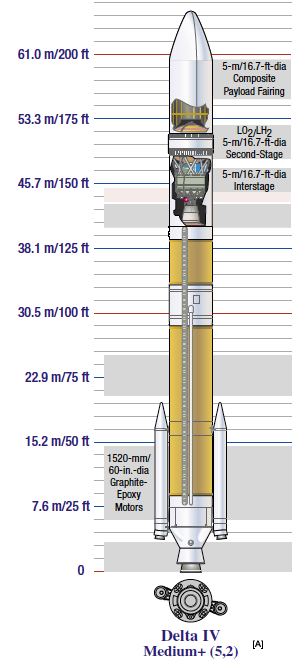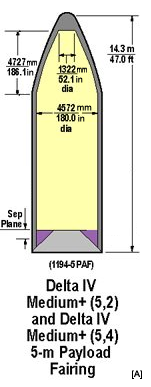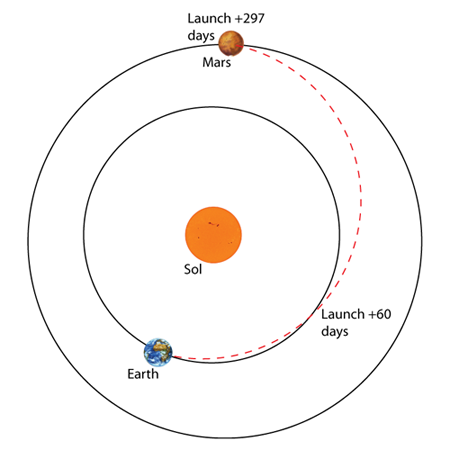
 Propulsion
Propulsion
Platform
In order to launch five constellations of three satellites (plus one redundant satellite per constellation), five separate launches are required. Each launch will distribute its payload around Mars 72º away from the previous constellation. The launch vehicle is a Boeing Integrated Defense Systems Delta IV Medium+ (5,2) with two Graphite-Epoxy Motors (GEM-60). The Delta IV medium+ (5,2) specifications are shown below [1]:

| Rocket | Delta IV Medium+ (5,2) (Delta 9250) w/ 2 GEMs |
| Stages | 2 + boosters |
| Liftoff Thrust | 940,421 lbf |
| Total Mass | 292,732 kg |
| Payload Weight | 4350 kg to earth escape |
| Payload Fairing | 5m diameter, 14.3m height |
| Fuel Type | Stage 1 - (Rocketdyne RS-68) Lox/LH2, 249 second max burn |
| Fuel Weight | Stage 1 - 199,640 kg of fuel |
| Price | $150,000,000 (2004 dollars)/ea. |
Stages
The first stage of the Delta IV Medium+ (5,2) utilizes the powerful gas generator, pump-fed Rocketedyne RS-68 Lox/LH2 motor with a thrust of 294,835 kg. This thrust yields a thrust-to-weight ratio of 51.2. The RS-68 was designed to be 30% more efficient than other conventional LOX/Kerosene engines. Since it uses liquid oxygen and liquid hydrogen, combustion produces only environmentally friendly steam [2].
 The Delta IV Medium+ (5,2) also has a larger payload fairing, allowing an entire constellation to be launched on one rocket. The aluminum five meter fairing is large enough to accomidate a stacked distribtion system whereby each satellite is ejected from the stack approximately at the correct position in orbit. Station keeping fuel is then used to position and stabilize the final orbit. This approach minimizes the amount of fuel necessary to position the constellation. The GPS satellites used for the Mars Global Positioning System weigh 900 kg each. With four satellites per launch, the total payload weight will be 3600kg. An additional 500kg will be necessary to provide the coupling and satellite distribution assembly, bringing the total launch payload to 4100kg, which is 250kg below the rated payload weight.
The Delta IV Medium+ (5,2) also has a larger payload fairing, allowing an entire constellation to be launched on one rocket. The aluminum five meter fairing is large enough to accomidate a stacked distribtion system whereby each satellite is ejected from the stack approximately at the correct position in orbit. Station keeping fuel is then used to position and stabilize the final orbit. This approach minimizes the amount of fuel necessary to position the constellation. The GPS satellites used for the Mars Global Positioning System weigh 900 kg each. With four satellites per launch, the total payload weight will be 3600kg. An additional 500kg will be necessary to provide the coupling and satellite distribution assembly, bringing the total launch payload to 4100kg, which is 250kg below the rated payload weight.
The larger 5 meter second stage, in addition to supporting a larger payload fairing, has a 0.5 meter longer oxygen propellant tank as well as a hydrogen tank that is 1 meter larger in diameter. This additional fuel capacity allows the Delta IV Medium+ (5,2) to escape earth's gravitational field with a sizable payload. The larger tanks allow for an additional 5 minutes of burn time.
The Delta IV Medium (5,2) is the most cost efficient launch platform for distribution of the Martian Global Positioning System. The Delta IV rocket costs around $19,000 in fuel to launch 1 kg. With a total payload of 4300kg, the launch cost will be $81 million per rocket. Adding this to the non-recoverable cost of the rocket, it will cost $181,000,000 per launch. This system will require five launches resulting in a total launch cost of $905,000,000. If the comparable Ariane rocket was used, the launch cost would be $1,211,875,000. The Delta IV is the perfect platform for a Martian satellite launch [3].
Launch Sequence [4]
- Launch from Cape Canaveral Air Force Base pad SLC-37 during optimal Mars launch window.
- Initiate Launch
- Stage 1 will provide 100% thrust at liftoff. Thrust throttled to 60% at 56 seconds and throttled back

up to 100% at 252-257 seconds. Thrust cut-off at 327 seconds followed by separation at 332 seconds. - GEM 100% burn for 100 seconds, then jettisoned
- Following separation, stage 2 will burn for between 500 and 1070 seconds to provide proper trajectory for Mars intercept.
- The satellites would reach Mars and be distributed in their respective polar orbits in slightly over 9.5 months
Interplanetary Trajectory
The interplanetary trajectory for a Mars launch would place the satellites in polar Martian orbit in 297 days (approx. 9.5 months). The trajectory would involve six trajectory correction maneuvers. The first two correction maneuvers occur at launch plus 6 days and launch plus 60 days. These short burns correct any error in velocity or heading from the initial earth escape. At arrival minus 45 days another trajectory correction is made to tighten the arc and correct any undesired drift.
At arrival minus 15 days, arrival minus 8 days, and arrival minus 22 hours, three short reverse burns are used to gradually slow the craft so that it enters the proper Martian orbit at the proper velocity [5]. Once in polar orbit, the satellite distribution will occur.
The four launches must be timed such that they enter the correct 72º separated Martian orbits. The final three trajectory correction maneuvers can be used to alter the arrival time, thereby allowing for each rocket to enter into the correct orbits [6].
Reference Clock and Mars-Earth Data Link
 A probe in the nose of the fifth rocket will be jettisoned towards the Martian surface following distribution of the final constellation. This probe will enter the atmosphere and parachute to the surface at the north pole. There are no dust storms at the north pole, which alleviates the problem of the iron-rich dust particles causing sub-optimal dish antenna operation (although heaters will be required to remove CO2 ice which sublimates onto surfaces when the temperature drops below the sublimation point). This probe will contain an atomic clock, an atmospheric accumulator fuel processor, a time synchronization/data link antenna as well as a steerable dish antenna for the Mars-Earth relay link.
A probe in the nose of the fifth rocket will be jettisoned towards the Martian surface following distribution of the final constellation. This probe will enter the atmosphere and parachute to the surface at the north pole. There are no dust storms at the north pole, which alleviates the problem of the iron-rich dust particles causing sub-optimal dish antenna operation (although heaters will be required to remove CO2 ice which sublimates onto surfaces when the temperature drops below the sublimation point). This probe will contain an atomic clock, an atmospheric accumulator fuel processor, a time synchronization/data link antenna as well as a steerable dish antenna for the Mars-Earth relay link.
Placing the probe at the north pole will ensure that the synchronization occurs more often. This system will broadcast a 40W beacon signal and receive return signals containing time synchonization data as well as system diagnostic information and telemetry. Each satellite will pass over the probe once a day. The satellite closest to the north pole will be the root node for the satellite mesh communications. The other satellites will send diagnostic data and system status information via the root node to the Mars probe for relay to Earth. This method is preferable to placing dishes for Earth communication on each satellite due to weight and power considerations. If a steerable dish had to be placed on each satellite, the weight would require additional launches as well as higher complexity.
The details of the Mars-Earth communication link can be found on the communications systems page.
[1] http://www.geocities.com/launchreport/delta4.html, http://www.astronautix.com/lvs/deltaiv.htm
[2] http://www.boeing.com/news/feature/paris2005/assets/ids_pdfs/Delta%20IV%20BCKGR%20March%202005.pdf
[3] http://www.aviationweek.com/shownews/01paris1/airfrm26.htm
[4] http://www.braeunig.us/space/specs/delta.htm
[5] http://marsprogram.jpl.nasa.gov/MPF/mpf/mpfcruise.html
[6] Notes from Georgia Tech course HTS 4823
Images: [A] http://www.ulalaunch.com/docs/publications/Delta/Delta_IV_Technical_Summary_Boeing_version_flyer.pdf